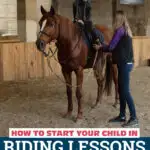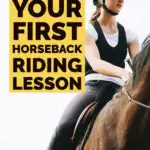Everything you ever wanted to know about horseback riding lessons – from your first lesson to becoming an instructor.
Horseback riding lessons are many people’s first experience of horses. Unlike generations past, few of us have lifestyles that allow us regular contact with horses. Instead, horseback riding lessons are the best way to learn to ride a horse.
In this article, we will discuss:
- the general cost of taking horseback riding lessons.
- the benefits of horseback riding lessons.
- what to know before getting started and how to prepare for your first lesson.
- plus, what lessons might look like as you develop your skills as a rider.
Paying for Horseback Riding Lessons
Horseback riding lessons can be expensive. But there are some ways to manage the costs of learning to ride if you aren’t able to afford the cost of regular horseback riding lessons.
How Much do Horseback Riding Lessons Cost?
The cost of horseback riding lessons varies dramatically around the world and even from geographic region to geographic region within the United States. Horseback riding lessons at a competitive showjumping stable in San Francisco or upstate New York may cost over $100 per 45-minute lesson, while horseback riding lessons at a casual, hobby-oriented riding stable in suburban Texas or Georgia may cost as little as $30-50 per 45 minute lesson. Group lessons or lesson-packages may make riding lessons as low as $25/hr in some areas.
The price of riding lessons varies widely, and if you are in an area that has multiple riding stables with horseback riding lessons, you can shop around to find the right fit.
Many times, the most expensive riding lessons are taught by highly competitive, horse show-oriented riding instructors. If your interest is simply to learn to ride for fun, not for show, you don’t need to pay for expensive competition-oriented lessons, training, and coaching.
Why are Horseback Riding Lessons so Expensive?
Horseback riding lessons are expensive because horse businesses are notoriously low-profit. Bundled into the cost of one 45 minute riding lesson is the cost of purchasing a horse, training a horse to be safe for beginner riders, horse feed, horse shoes, and veterinary care, as well as expenses involved in running a stable – like a mortgage on the property, building maintenance, and liability insurance to protect the riding stable. An additional cost that makes riding lessons expensive is the expertise and time of a good riding instructor.
Good riding instructors are both excellent, experienced riders who understand horse training, and good teachers who understand the fundamentals of human psychology and education. A good riding instructor manages the mechanics of riding, plus new riders’ nerves about riding or trying a new gait, all with the capacity to make the riding experience fun.
Tips for Making Horseback Riding Lessons More Affordable:
If you’d like to take horseback riding lessons but find that they are a little out of you or your family’s budget, there may be options. Some options to reduce the cost of horseback riding lessons include:
Working student arrangement – One common way that young riders are able to afford frequent riding lessons is by becoming a working student. A working student might arrive a few hours early or stay a few hours late after their horseback riding lesson to do barn maintenance, chores, and other manual labor around the farm.
Many students enjoy grooming horses, cleaning stalls, and cleaning tack and equipment, so this arrangement often works out well for both stables and riders. For adults, one version of a working student arrangement can even include bartering a professional skill or services for riding lessons.
Group or package discounts – Ask the riding stable if their fees change based on how many students are in the lesson, or how many lessons are purchased at once. Often, stables have a pricing arrangement so that when purchasing, for example, six lessons upfront, the seventh lesson is free. Purchasing lesson packages overall reduce the cost of riding lessons.
Alternately, if the stable doesn’t offer group lessons (which are typically less expensive than private lessons) you can ask around to see if another rider at the barn would like to share a private lesson (you probably won’t be able to spit split the cost of a private lesson in half, but the cost for two of you to ride should be less than the solo price.)
Providing your own lesson horse – Either through purchasing a horse or sharing a horse with someone else (called a “half lease”), supplying your own horse can reduce fees connected to using a riding stable’s horses.
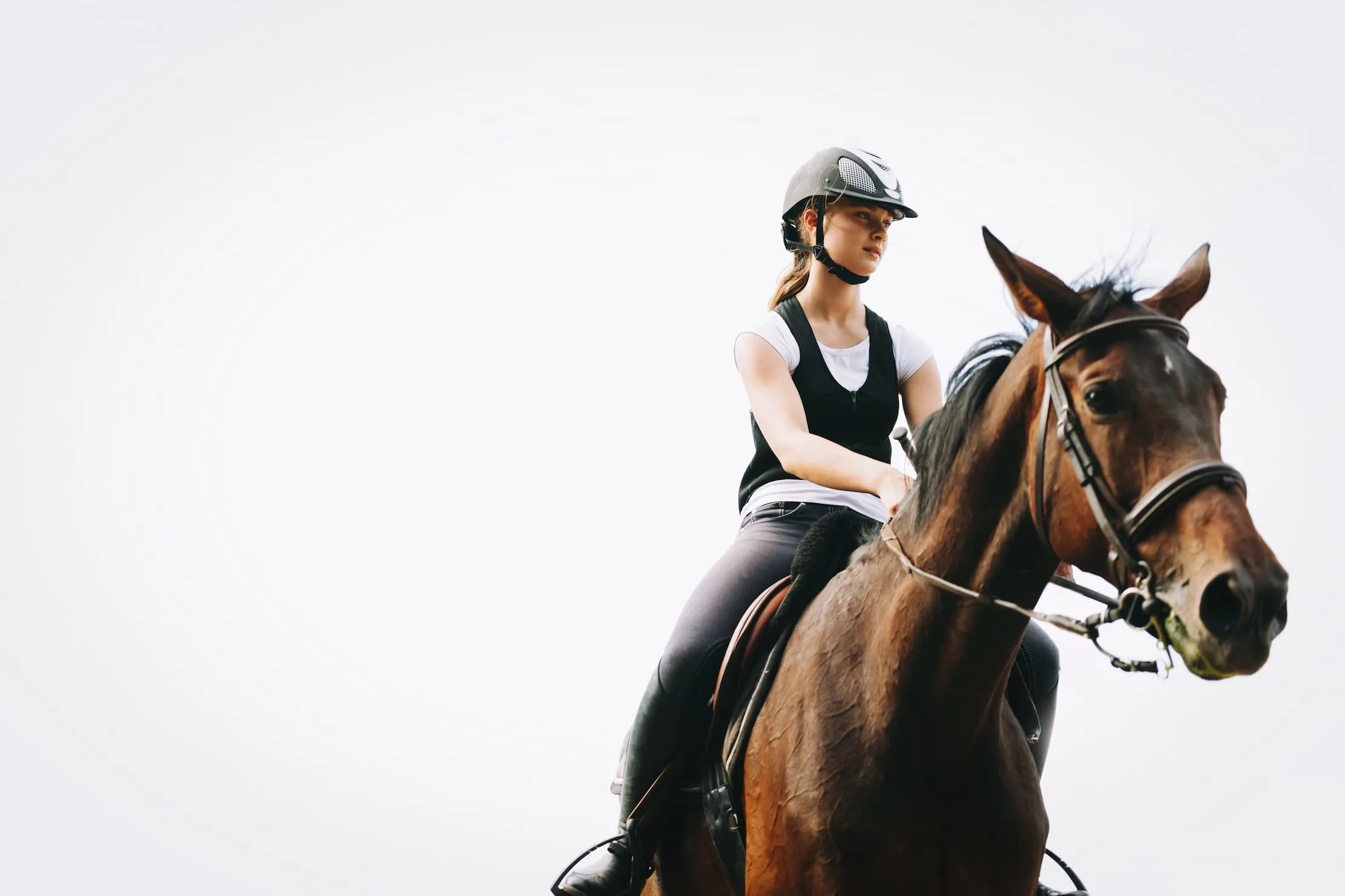
What to Expect from Horseback Riding Lessons
Many people aren’t sure what to expect from horseback riding lessons. They might wonder how long it will take to learn to ride confidently, ride a gallop, take their fist horse jump, or enter their first horse show. While the timetable for learning will vary from one rider to another, here are some things you can expect for you or you child’s first lesson:
The first 10-20 minutes of your first horseback riding lesson will probably consist of:
- learning how to groom and put equipment on your horse (called tacking up).
- basic safety instructions.
- mounting a horse correctly.
The rest of the first lesson will be spent learning to:
- correctly and safely hold the horse’s reins
- Sit in the saddle with your legs and upper body in the right position
- Riding around an enclosed area at a walk,
- Steering the horse using the reins and your body.
Virtually all first-time horseback riding lessons will take place in an enclosed arena or corral, so you don’t have to worry about your horse running away.
Don’t be surprised if your riding instructor keeps a long lead on your horse (called a lunge line) throughout the whole lesson. This European method of teaching new horseback riders allows a rider to focus 100% on balance, posture, and movement without the added complication of steering your horse.
You Can Expect a Safe Horse
Any good riding stable will assign you to a safe, quiet, and probably very old horse for your very first riding lessons. A good first-lesson horse has likely taught many new riders and should be patient, slow, and quiet. If you are put on a horse for your first lesson that seems nervous, jumpy, or agitated, it’s a red flag that you may be shouldn’t return for another lesson at that stable – as this type of horse is inappropriate and unsafe for a brand-new rider.
You may wonder what breed of horse is will be used in your riding lesson. The most common breeds of horses used for horseback riding lessons are Quarter Horses, Thoroughbreds, and Arabian Horses- not because these breeds are particularly safe for riding lessons, but because they are the most common breeds in the United States. Some stables may use other breeds of horses, including Haflingers, Shetland Ponies, and even rare breeds like Bashkir Curly Horses.
Expect to Stay at a Gait Until You are Bored
You can expect to learn to ride your horse at faster gaits as you are ready. When you’re comfortable, balanced, and feel a little bit bored walking your horse around the arena, your instructor will teach you how to signal for a trot. Most riders master the walk and are ready to try trotting by the end of their second or third horseback riding lesson. Your instructor will teach you to sit the trot or post (rise out of the saddle with each stride).
The canter is the next faster gait from the trot. The canter is much faster than a trot and can make siders feel out-of-control and panicky if they try it too soon.
How fast your instructor moves you up to the canter will vary a lot from rider to rider. If you are in weekly lessons, generally fit, and have reasonably good balance, you’ll probably start cantering about 2 to 3 months into weekly horseback riding lessons. For tips on learning to canter with confidence, refer to our article on learning to canter. With time, you’ll learn to control a horse’s pace within each of the three gaits.
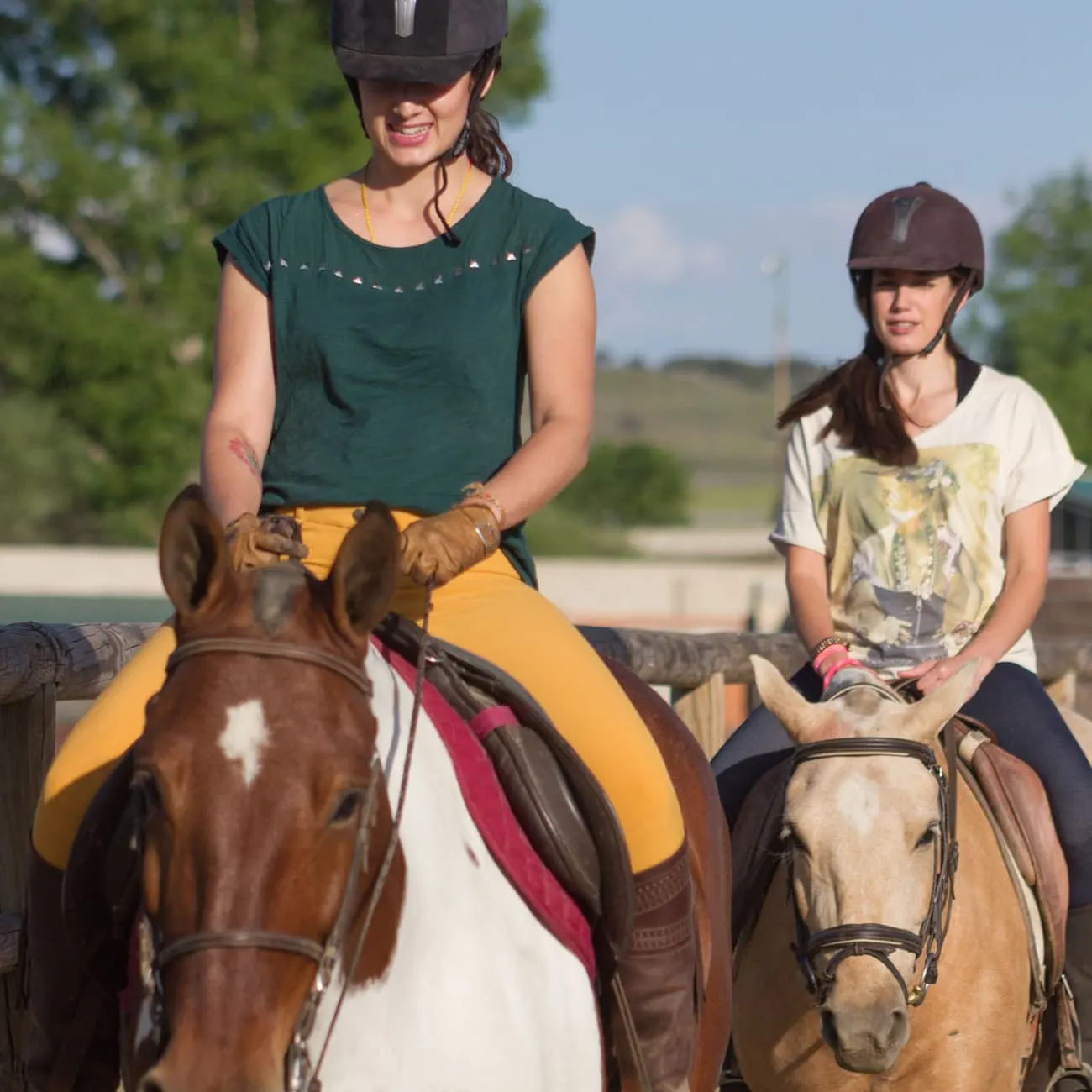
When to Expect to Jump Your Horse in Riding Lessons
Many riding stables have a rule that you must ride for one year before beginning to jump in your riding lesson. This is because learning to jump horses is more likely to cause a fall, and requires very good balance and the ability to control a horse. By spending a year in the saddle developing muscle tone, coordination, and the muscle-memory to use your body properly while riding, you’ll be ready to move on to jumping-focused riding lessons in about a year – although, like all timelines, this can vary widely from rider to rider and from stable to stable.
Not all horseback riding lesson stables offer jumping lessons, so if this is your goal as a rider ask early or be prepared to change to a new riding stable when you are ready to begin jumping,
Riding Lessons at Any Age
Often, riding lessons are seen as an activity for children and teens, but as the research on the benefits of horse-human connection pile up in academic journals, more and more adults are seeking horseback riding experiences without the expense of purchasing and owning their own horse. If you’re an adult thinking of taking riding lessons, you’re not alone – at any riding stable around the world, you are likely to ask encounter other riders who started riding lessons in their 20s, 30s, 40s, and even 50s and 60s.
Learning to ride as an adult may be slightly more physically challenging or even involve more emotional blocks (as adults, we are more inclined to be aware of the risks when learning to ride compared to kids) but it’s a hurdle many new adult riders overcome each year. There are even clubs, organizations, and riding groups designed specifically for adult beginner riders. If you are lucky enough to live near a bustling riding stable, you may even be able to find a group lesson just for adult beginner riders.
Choosing How Often to go to Horseback Riding Lessons
Because horseback riding lessons are a physical activity that’s more fun the more conditioned your body becomes to the activity, it’s best to take riding lessons at least one time a week. Once a week horseback riding lessons help ensure that muscles stay conditioned and growing stronger. While you may be sore after your first few lessons, if you consistently ride at least once a week, the soreness will go away after future lessons- However, if you take riding lessons less than once a week, you may find yourself stuck in a loop of soreness after every single horseback riding lesson.
Soreness After Horseback Riding Lessons
It’s normal to feel sore after horseback riding lessons. Horseback riding stretches muscles and tendons in the groin, back, legs, and even abdomen that other activities don’t stretch. It’s been said that only the sports of horseback riding and swimming use every single muscle in the body!
After your first few riding lessons, you can expect to dismount feeling a little wobbly and weak in the knees.
The next day after your riding lesson you’ll probably feel very sore, but the soreness will decrease with each riding lesson. After about 2-3 weeks of weekly riding lessons, you’ll probably stop feeling sore after most horseback riding lessons (even seasoned riders sometimes feel sore after a very long day in the saddle or doing a muscle-building riding activity like riding bareback or without stirrups).
Saddles Sores after Horseback Riding Lessons
If you find that horseback riding leaves physical sores on your body – chapped, rubbed, or chafed skin on your groin, inner legs, or buttocks- you’re dealing with saddle sores. Saddle sores can typically be resolved through a change in the type of clothing and equipment you’re using.
It’s typical for new riders to begin lessons without specialized clothing or equipment, but if you develop sores or chafing while riding, it’s a cue that it’s time to invest in riding clothing like riding tights, breeches, boots, and half chaps. Adding a power or gel-based skin lubricant can also reduce the friction that causes saddle sores. Read our recommendations for skin lubricants plus some other tricks to avoid saddle sores in our article on how to permanently resolve saddle sores.
Be sure to tell your riding instructor about any sores you got while riding. Sometimes saddle sores can be caused by riding in a saddle that doesn’t fit your body.
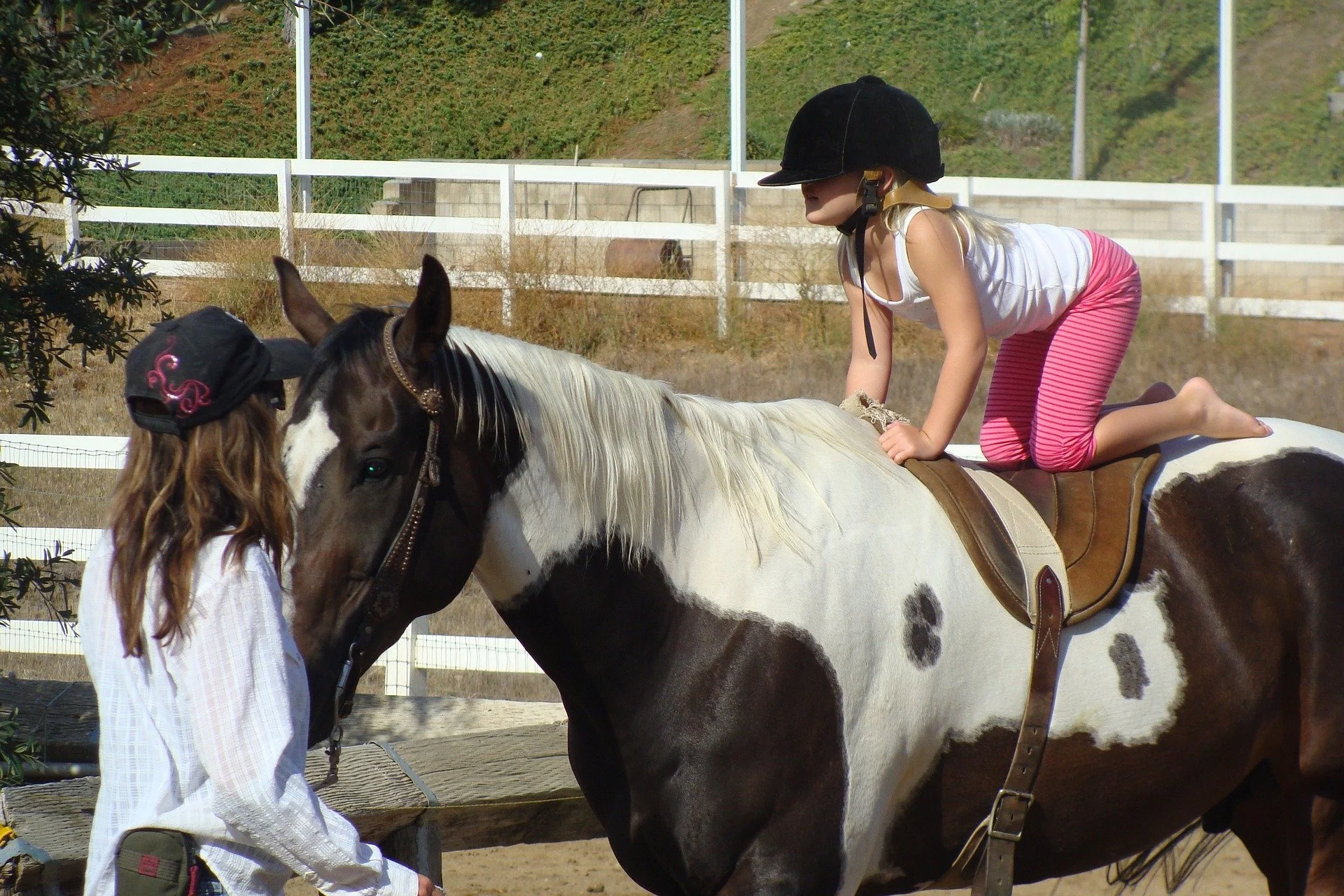
Are horseback riding lessons worth it?
Many riders, and especially the parents of young riders, wonder if the expense of horseback riding is really worth it. It’s easy to spend a small fortune on outfitting a rider with the right equipment and paying for lessons – and that’s before investing in horse ownership or competitions! As a riding coach, former horse-crazy kid, and mental health professional, I deeply believe that horseback riding lessons are worth it. If a young rider feels strongly drawn to taking horseback riding lessons, and a family is able to afford that privilege, they should. Why? Horseback riding has enormous benefits for all riders but especially young riders – including giving kids an analog, embodied experience, fun-based fitness, face-time with friends with shared interests, and a healthy, supportive place to grow into an individual beyond their immediate family.
Riding lessons encourage mind-body connection and emotional maturity in a way that’s different from other sports. For young female riders in particular, horseback riding lessons can offer a huge boost to body image.
What is the best age to start horseback riding lessons?
The best age for kids to start horseback riding is between 7 and 10 years old. Kids in this age bracket are curious, adventurous, and able to follow instructions- which helps them thrive as they start riding lessons. However, kids as young as 3 or 4 may benefit from the developmental benefits of horseback riding lessons1 There is no age that is too old to start riding lessons- in fact, getting involved with horses in old age has been linked to improved balance and mobility.2
More About the Best Age to Start Riding Lessons:
People who learn to ride horses as children or younger teens are often able to learn more intuitively (with their bodies rather than their brains). For adults, who learn more cognitively, the fear of falling off a horse can actually make it harder to develop confidence in the saddle.
Kids who learn to ride a horse while they are young, develop balance, a deep seat, and confidence to ride before the awareness of risk enters their brain. This tends to make them more confident, safe, riders in the long run (it also makes it harder to convince them to wear helmets, but that’s another conversation!)
Many kids don’t get interested in horseback riding until they are 12, 13, or even 14 – and it’s not too late to start horseback riding. If your 12 or 13-year-old starts riding lessons, they’ll be in good company with other beginner horseback riders their own age.
Like most sports, you’re unlikely to make the Olympic team if you start riding lessons as a teenager or adult. However, there’s no age limit for enjoying horses!
What to Wear to a Horseback Riding Lesson
For your first horseback riding lesson, it’s okay to show up to the barn in a casual top, leggings, or jeans, and some sort of boot with a heel. If you enjoy your lesson and choose to continue horseback riding, you’ll need to purchase some riding clothes to make riding more safe and fun, but for your first lesson long pants and boots, are typically the only requirement (along with a helmet, which your riding stable will assign you before your ride).
For more information on the types of clothing you might want to invest in for your or your child’s riding lessons, check out our article on what to wear horseback riding – including specific outfit ideas for both English and Western horseback riding lessons.
Choosing Between English and Western Horseback Riding Lessons
Often, because there aren’t an abundance of riding stables in the US, we don’t get to choose between English or Western riding lessons. Whatever stable is local typically has a preference for one or the other and teaches only that type of riding.
If you do have the opportunity to choose between English and Western styles of riding, it may be helpful to read our article on the difference between English and Western riding. It’s okay to take the first few lessons in one style and then switch to the other (in fact, many English stables starting very young kids will put them in Western saddles until the young rider begins to develop better balance).
Most people who want to trail ride or do rodeos will start with Western riding lessons, while riders with goals for jumping horses will start in English riding lessons. Many riders ride interchangeably in both styles, although there are slight differences in posture and the cues given to a horse, particularly at higher levels of training and competition in each of those disciplines.
- Lee, P. T., Dakin, E., & McLure, M. (2016). Narrative synthesis of equine‐assisted psychotherapy literature: Current knowledge and future research directions. Health & Social Care in the Community, 24(3), 225-246. [↩]
- de Araújo, T. B., de Oliveira, R. J., Martins, W. R., de Moura Pereira, M., Copetti, F., & Safons, M. P. (2013). Effects of hippotherapy on mobility, strength and balance in elderly. Archives of gerontology and geriatrics, 56(3), 478-481. [↩]

